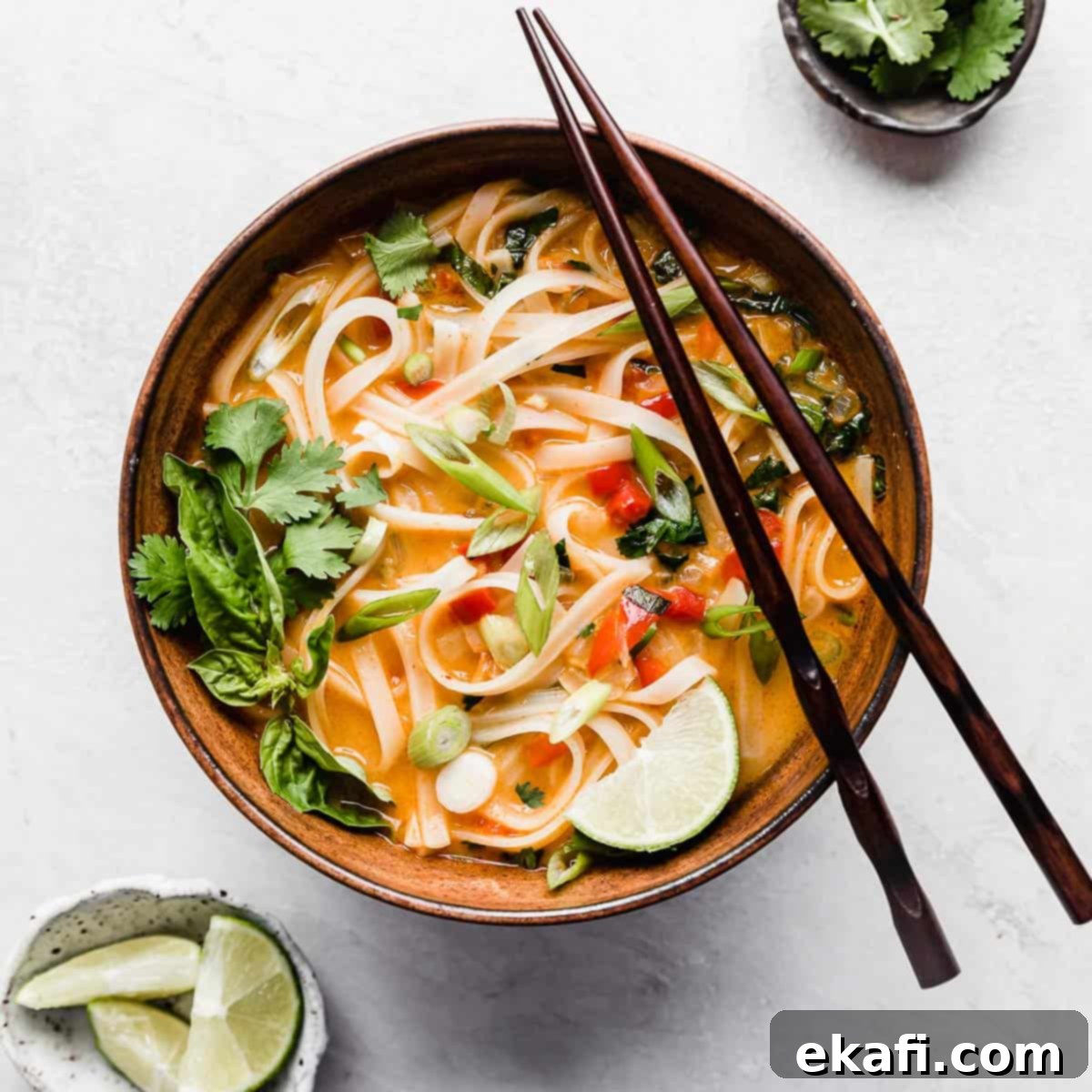Irresistible Thai Red Curry Noodle Soup: Your Go-To Weeknight Recipe
Embark on a culinary journey to Thailand from the comfort of your kitchen with this incredible Thai Red Curry Noodle Soup. Bursting with a vibrant spectrum of flavors and an aromatic blend of fresh ingredients, this recipe promises a warming, delicious, and deeply satisfying meal. From the zesty kick of fresh ginger and fragrant herbs to the creamy richness of coconut milk and the subtle spice of authentic red curry paste, every spoonful is an experience. Paired with tender rice noodles and garnished with crisp green onions, this soup is more than just a meal; it’s a heartwarming escape.
Many of us cherish the unique and complex flavors of international cuisines, often believing that restaurant-quality dishes like Thai curries or Indian delights are best left to professional chefs. But that notion is a thing of the past! With a few key ingredients and simple techniques, you can recreate your favorite ethnic dishes right at home, often surpassing what you’d find dining out. If you’ve enjoyed my Indian Butter Chicken recipe, explored the depths of my Massaman Curry, or savored my comforting Chicken Curry and Rice, you already understand the magic of homemade global cuisine. This Thai Red Curry Noodle Soup is no exception, bringing authentic taste and incredible aroma directly to your table.
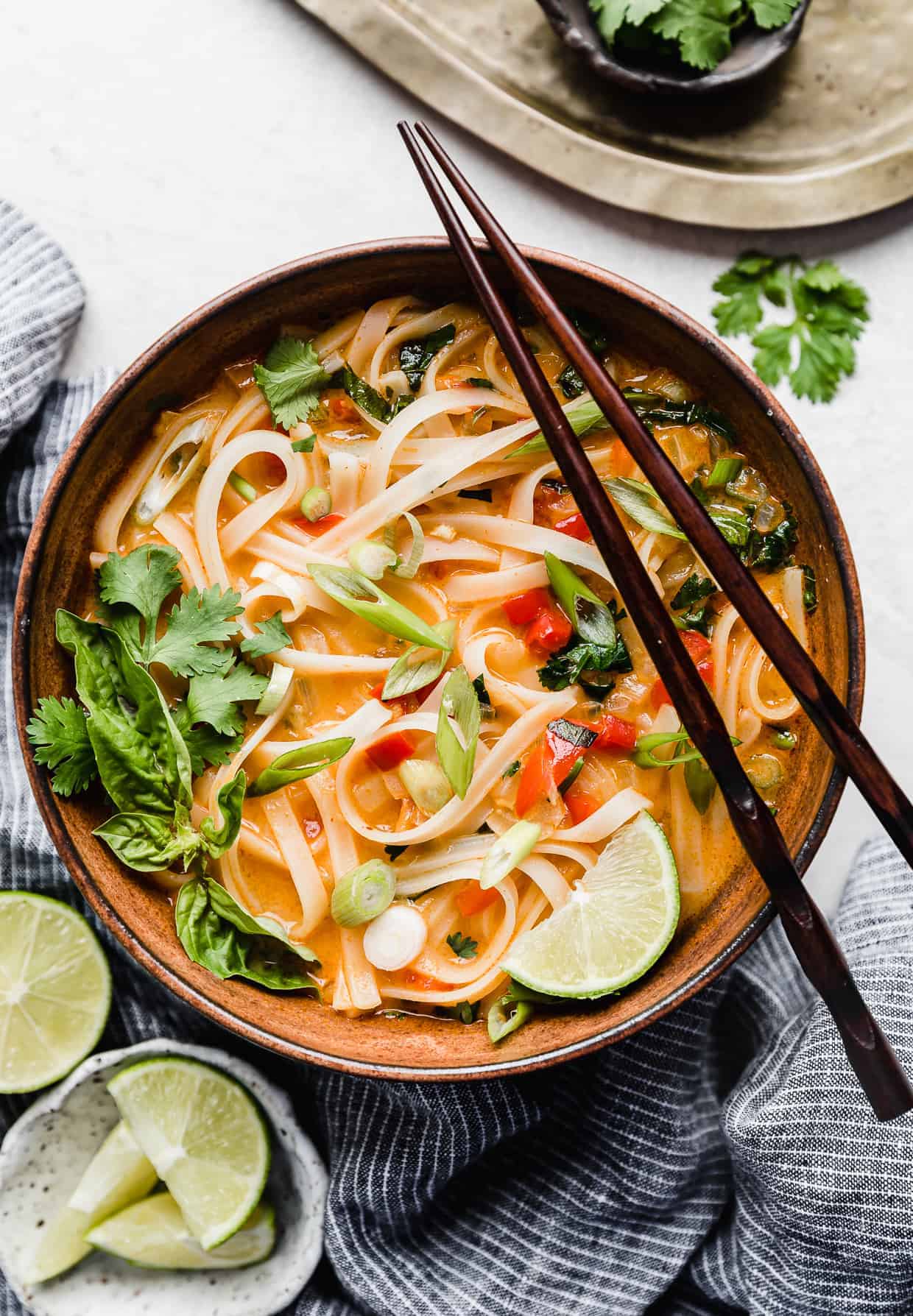
Why You’ll Love This Thai Red Curry Noodle Soup Recipe
This isn’t just another soup recipe; it’s a testament to how quick, healthy, and incredibly flavorful meals can be. Here’s why this Thai Red Curry Noodle Soup will quickly become a favorite in your household:
- A Speedy Dinner Solution in Just 25 Minutes! Don’t be intimidated by the rich, complex flavors or the list of fresh ingredients. This recipe is designed for efficiency and comes together surprisingly fast. From start to finish, you can have a piping hot, delicious meal on the table in just 25 minutes, making it an ideal choice for those hectic weeknights when time is of the essence but you still crave something extraordinary.
- A Wholesome and Refreshing Meal. Packed with an array of fresh vegetables and vibrant herbs, this soup offers a remarkably light and fresh taste profile. Unlike some heavier comfort foods, this curry noodle soup leaves you feeling satisfied and energized, not weighed down. The bright zest of lime juice perfectly complements the creamy, rich notes of coconut milk, creating a balanced flavor that truly invigorates the palate. It’s a delightful way to incorporate more goodness into your diet.
- Incredibly Versatile and Easy to Customize. One of the greatest advantages of this Thai Red Curry Noodle Soup is its adaptability to various dietary preferences and palates.
- Vegetarian-Friendly: Simply swap chicken broth for a high-quality vegetable broth, and you have a delicious meat-free meal.
- Protein Powerhouse: For the meat-lovers, effortlessly incorporate cooked protein such as shredded chicken (rotisserie chicken works wonders for speed!), grilled chicken pieces, or succulent cooked shrimp. Tofu or tempeh are also excellent plant-based protein additions.
- Adjustable Heat Levels: Whether you’re a spice enthusiast or prefer a milder warmth, this recipe caters to all. To dial up the heat, double the red curry paste amount or add a pinch of crushed red pepper flakes. If you’re sensitive to spice, don’t worry – this recipe as written is quite mild, but you can halve the red curry paste to ensure an even gentler flavor.
- Noodle Preference: Experiment with different rice noodle varieties to find your perfect texture.
Key Ingredients for Your Authentic Thai Noodle Soup
Crafting the perfect Thai Red Curry Noodle Soup begins with understanding the essential ingredients that contribute to its distinctive flavor profile. Here’s a closer look at what you’ll need and why each component is vital:
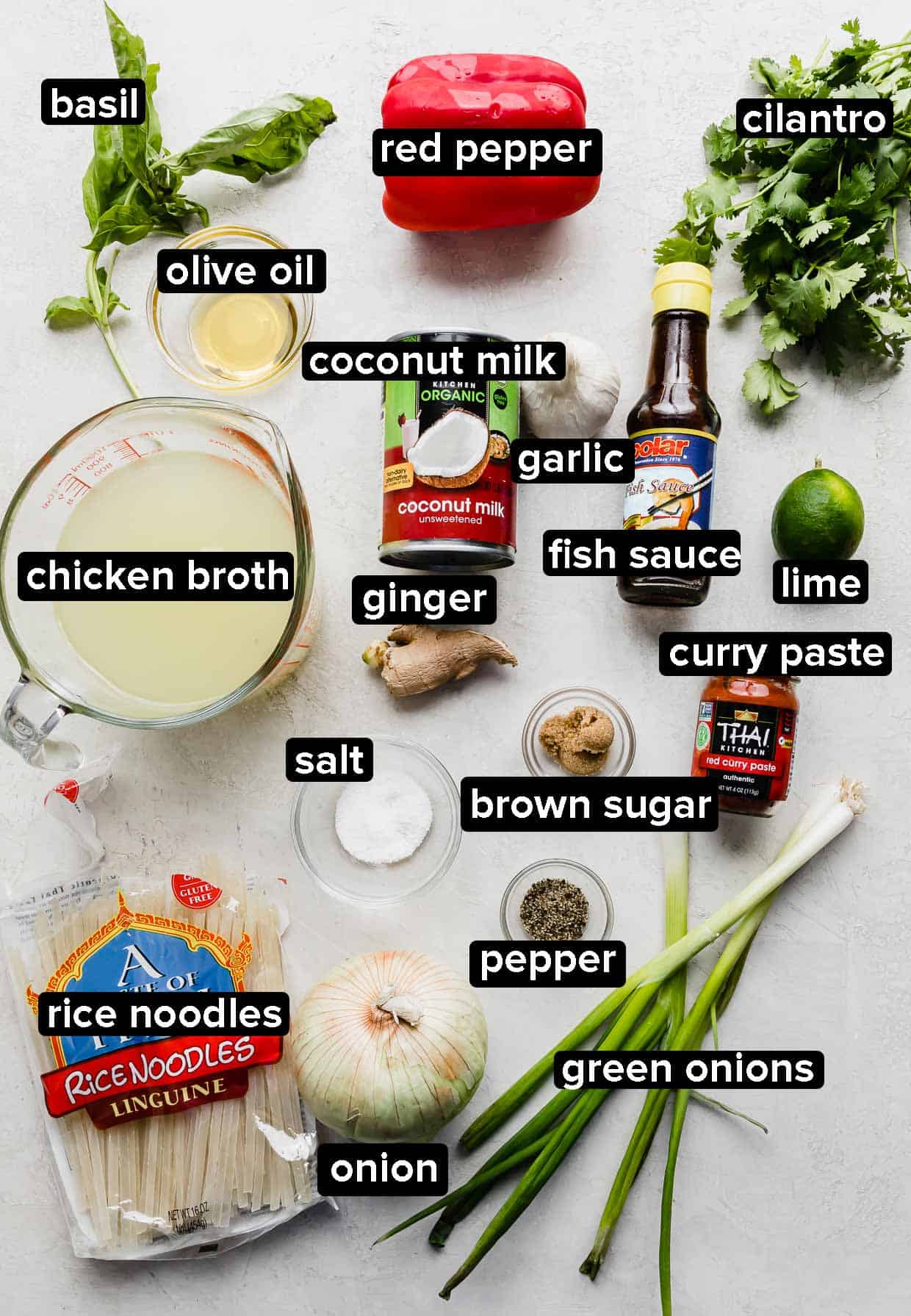
- Linguine Rice Noodles: These noodles provide a wonderful chewy texture that stands up beautifully to the rich broth. While I personally favor a thicker, more substantial noodle like linguine for this soup, any variety of rice noodles will work perfectly. Look for them in the Asian or international food aisle of your local grocery store. Thin vermicelli noodles are another popular choice for a lighter soup consistency.
- Red Curry Paste: This is the heart and soul of your curry! Red curry paste is a blend of red chilies, galangal, lemongrass, kaffir lime peel, coriander, cumin, garlic, and shallots, providing a complex and aromatic foundation. Brands like Maesri or Thai Kitchen are widely available and offer excellent flavor. You’ll often find it alongside other Asian ingredients. This versatile paste is also a star in my Coconut Curry Noodles recipe.
- Fish Sauce: An indispensable ingredient in Thai cuisine, fish sauce (Nam Pla) contributes a profound umami, earthy, and savory depth that truly elevates the dish. Its fermented flavor might seem strong on its own, but it perfectly balances the other ingredients in the soup.
- Coconut Milk: This creamy base is essential for the characteristic richness and mild sweetness of Thai curries. I recommend using full-fat coconut milk for the most luxurious texture and flavor, though lite coconut milk can be used if preferred, with minimal impact on consistency. It helps to mellow the spices and create that signature velvety broth.
- Thai Basil: Distinct from its Italian counterpart, Thai basil offers a unique flavor profile with notes of anise, licorice, and a hint of spice. It’s the perfect aromatic herb to finish off authentic Thai dishes, adding a fresh, vibrant punch.
- Lime: Fresh lime juice is crucial for adding a bright, acidic, and citrusy aroma that cuts through the richness of the coconut milk and balances the overall flavor. It’s a common and essential component in virtually all Thai curries and soups.
- Chicken Broth: The liquid base of our soup. Both low-sodium chicken broth and vegetable broth work wonderfully, allowing you to easily adapt this recipe for vegetarian diets without compromising on taste.
- Fresh Ginger: Adds a pungent, zesty, and warming spice that brightens the entire soup.
- Green Onions (Scallions): Used for both flavor and garnish, providing a mild oniony bite and a fresh green color.
- Fresh Cilantro: Offers a bright, herbaceous, and slightly citrusy note, a classic garnish for Thai dishes.
- Brown Sugar: A small amount of brown sugar helps to balance the savory, spicy, and sour elements, contributing to the harmonious sweet-salty-sour-spicy profile typical of Thai cooking.
Ingredient Substitutions and Creative Variations
Flexibility is key in cooking, and this Thai Red Curry Noodle Soup is incredibly forgiving. Here are some smart substitutions and variations to help you tailor the recipe to your pantry and preferences:
- Noodle Alternatives: If you prefer a thinner noodle, common choices include rice vermicelli noodles or even glass noodles. For those who enjoy a heartier texture, wide rice noodles or even regular spaghetti (though less traditional) can be used in a pinch. Just be mindful of cooking times, as they vary greatly between noodle types.
- Fish Sauce Substitute: Fish sauce is a cornerstone of Thai flavor, but if you don’t have it or prefer to avoid it, a common substitute is soy sauce. In Thai cooking, light soy sauce is often preferred because it offers a more delicate flavor than regular soy sauce, allowing other ingredients to shine. While soy sauce will provide a salty, umami note, it won’t replicate the specific briny, caramel-like sweetness of fish sauce. Please note that I have not personally tested this soup with soy sauce, so the flavor profile will be slightly altered.
- Basil Swap: If authentic Thai basil is unavailable in your area, regular sweet basil makes a perfectly acceptable substitute. While it won’t have the distinct anise notes of Thai basil, it will still lend a fresh, herbaceous quality to the soup.
- Vegetarian Adaptation: As mentioned, simply use vegetable broth instead of chicken broth to make this soup entirely vegetarian or vegan. Ensure your red curry paste is also vegan-friendly, as some brands may contain shrimp paste.
- Add More Protein: Elevate your soup with additional protein. Beyond chicken or shrimp, consider adding slices of lean beef, tender pork, or even firm tofu for a plant-based option. Cook your chosen protein separately and stir it in at the end to prevent overcooking and maintain optimal texture.
- Boost the Veggies: Enhance the nutritional value and texture by adding extra vegetables. Sliced mushrooms, baby corn, bamboo shoots, spinach, bok choy, or snap peas would all be fantastic additions. Add firmer vegetables along with the bell pepper and onion, and softer greens closer to the end of cooking.
Step-by-Step Instructions: Crafting Your Thai Red Curry Noodle Soup
Creating this flavorful soup is straightforward. Follow these simple steps for a perfect bowl every time:
- Sauté Aromatics: In a large pot or Dutch oven, heat the olive oil over medium heat. Add the diced bell pepper and onion, and cook until they soften and become translucent, which typically takes about 4 minutes. Stir in the minced garlic and cook for an additional minute until fragrant, being careful not to burn it.
- Bloom the Curry Paste: Stir in the red curry paste, grated fresh ginger, kosher salt, and black pepper. Cook this mixture for 1 minute, stirring constantly, allowing the curry paste to “bloom” and release its rich aromas and flavors. This step is crucial for developing the soup’s depth.
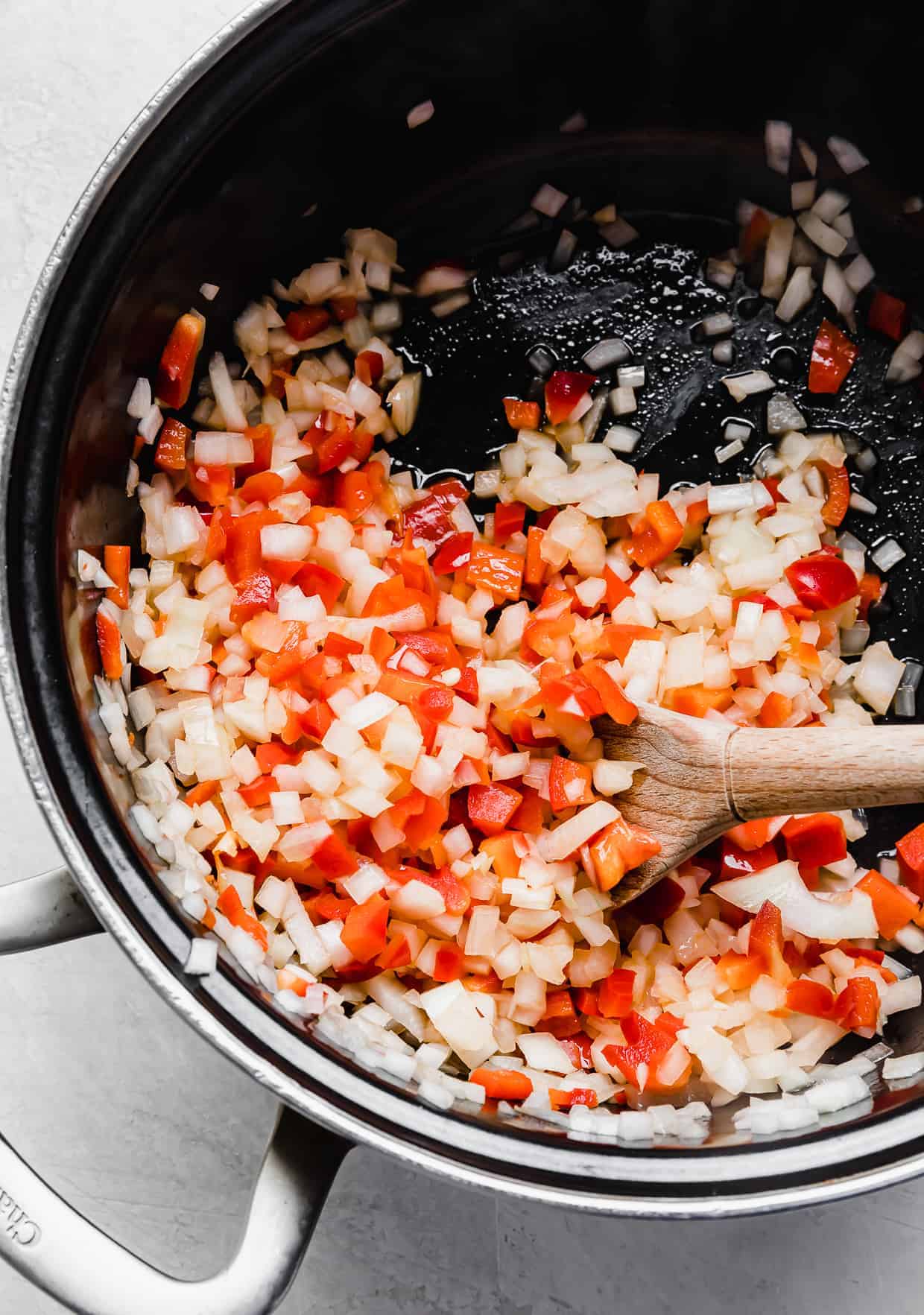
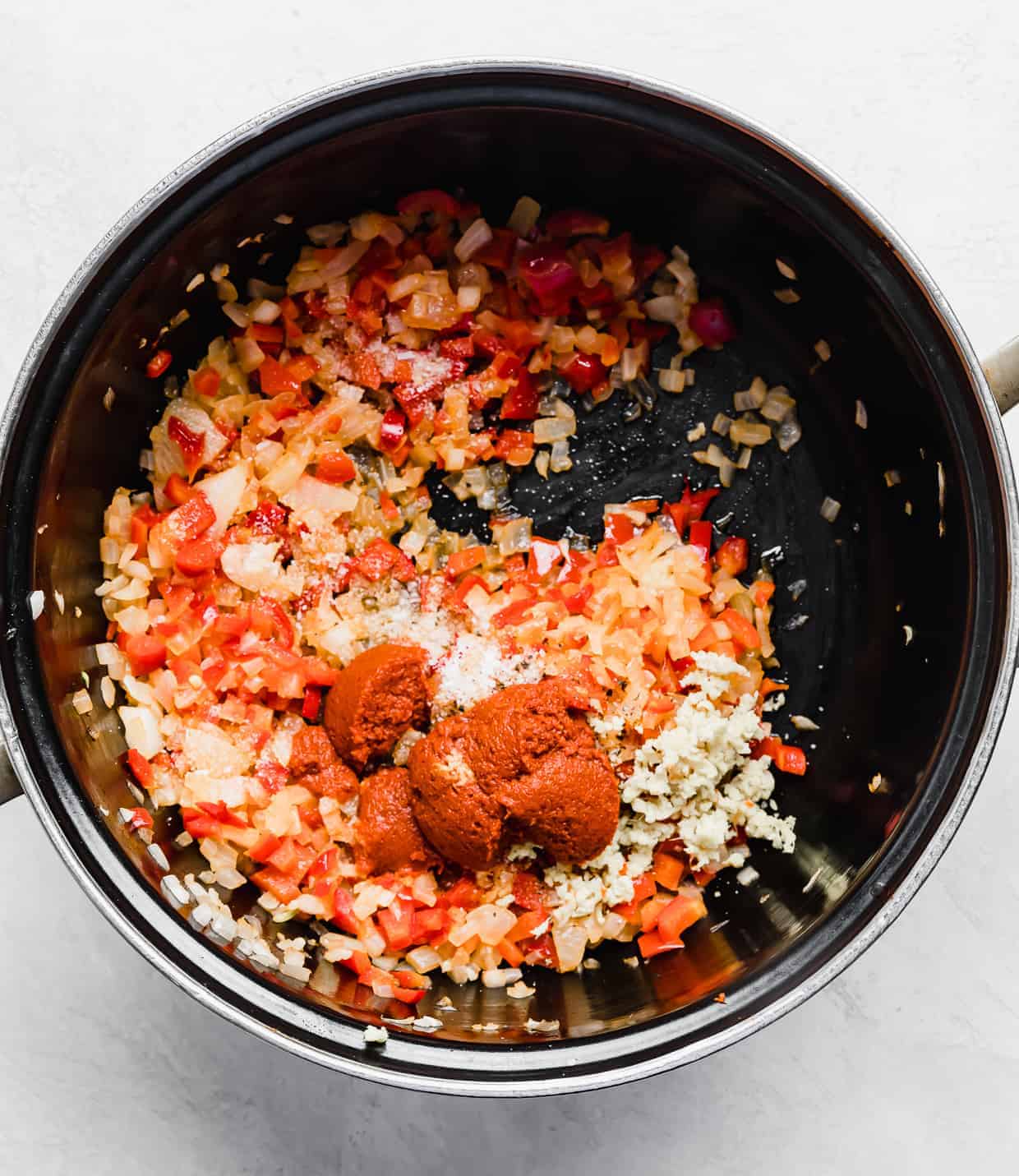
- Simmer the Broth: Pour in the chicken or vegetable broth and the creamy coconut milk. Bring the mixture to a gentle boil, stirring occasionally to ensure all the flavors meld together beautifully.
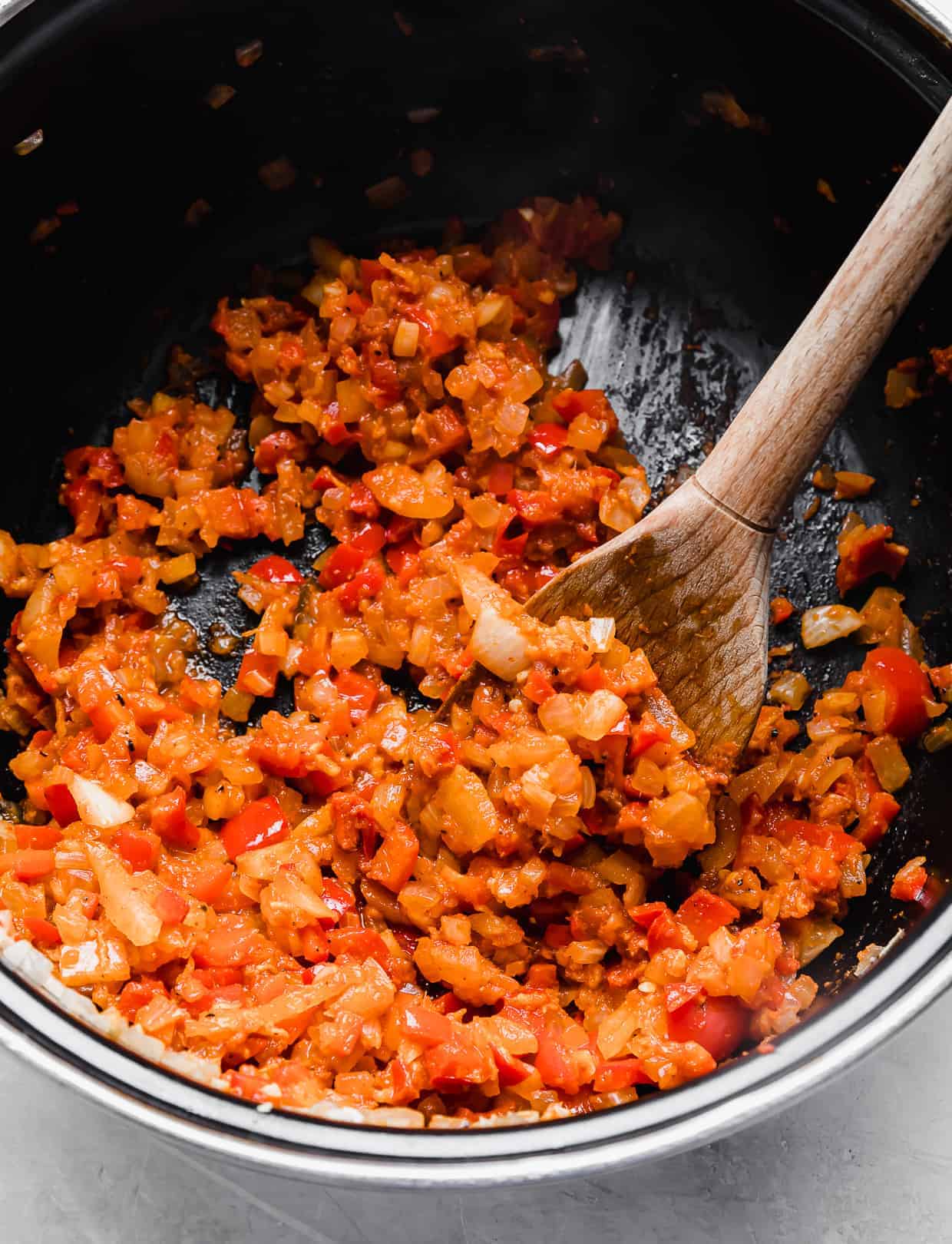
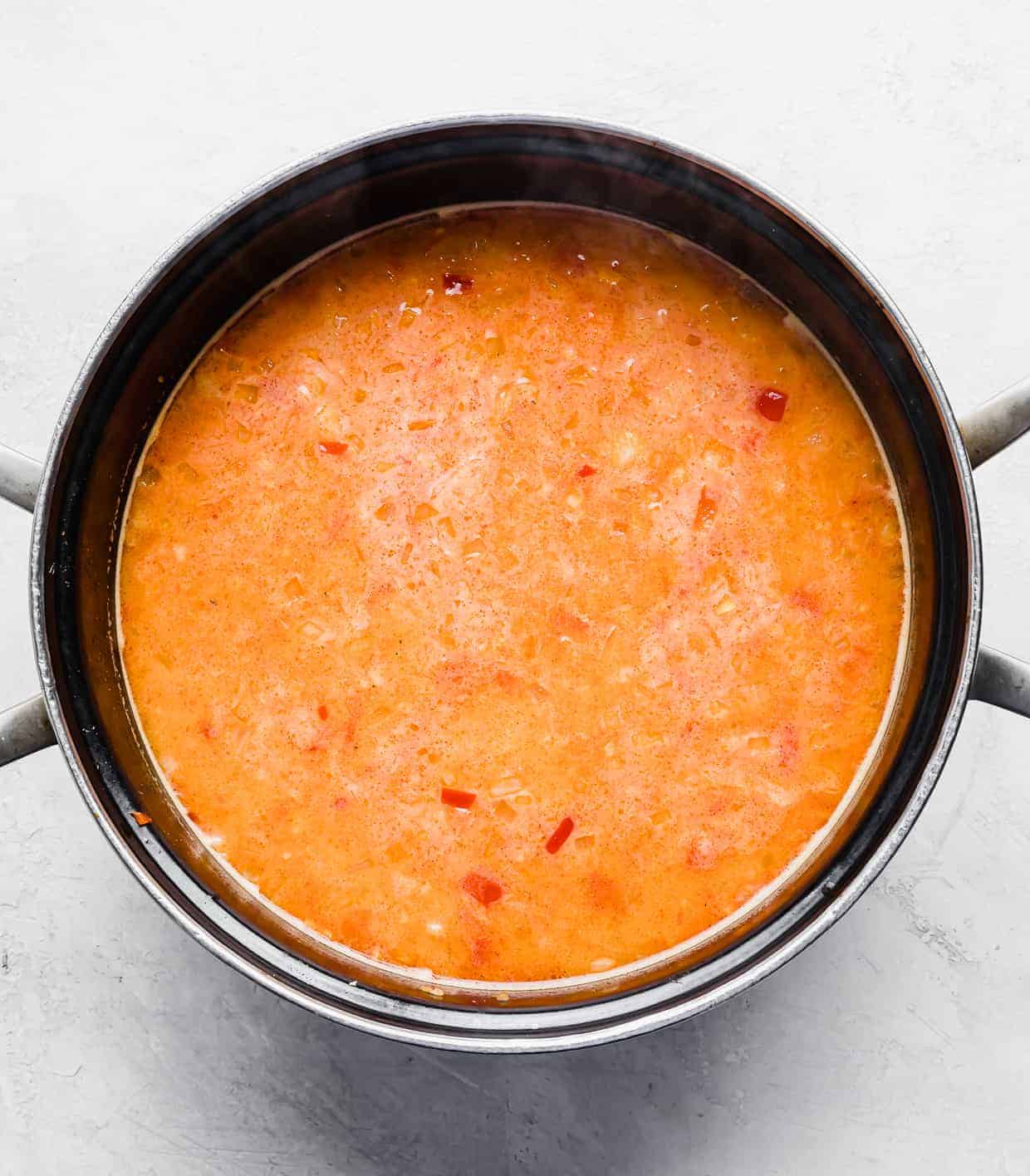
- Cook the Noodles: Once the mixture is boiling, add the rice noodles, fish sauce, and brown sugar. Cook until the noodles are perfectly tender. This typically takes about 4 minutes for linguine rice noodles, but cooking time will vary depending on the type and thickness of the rice noodles you choose. Ensure they are al dente and not overcooked.
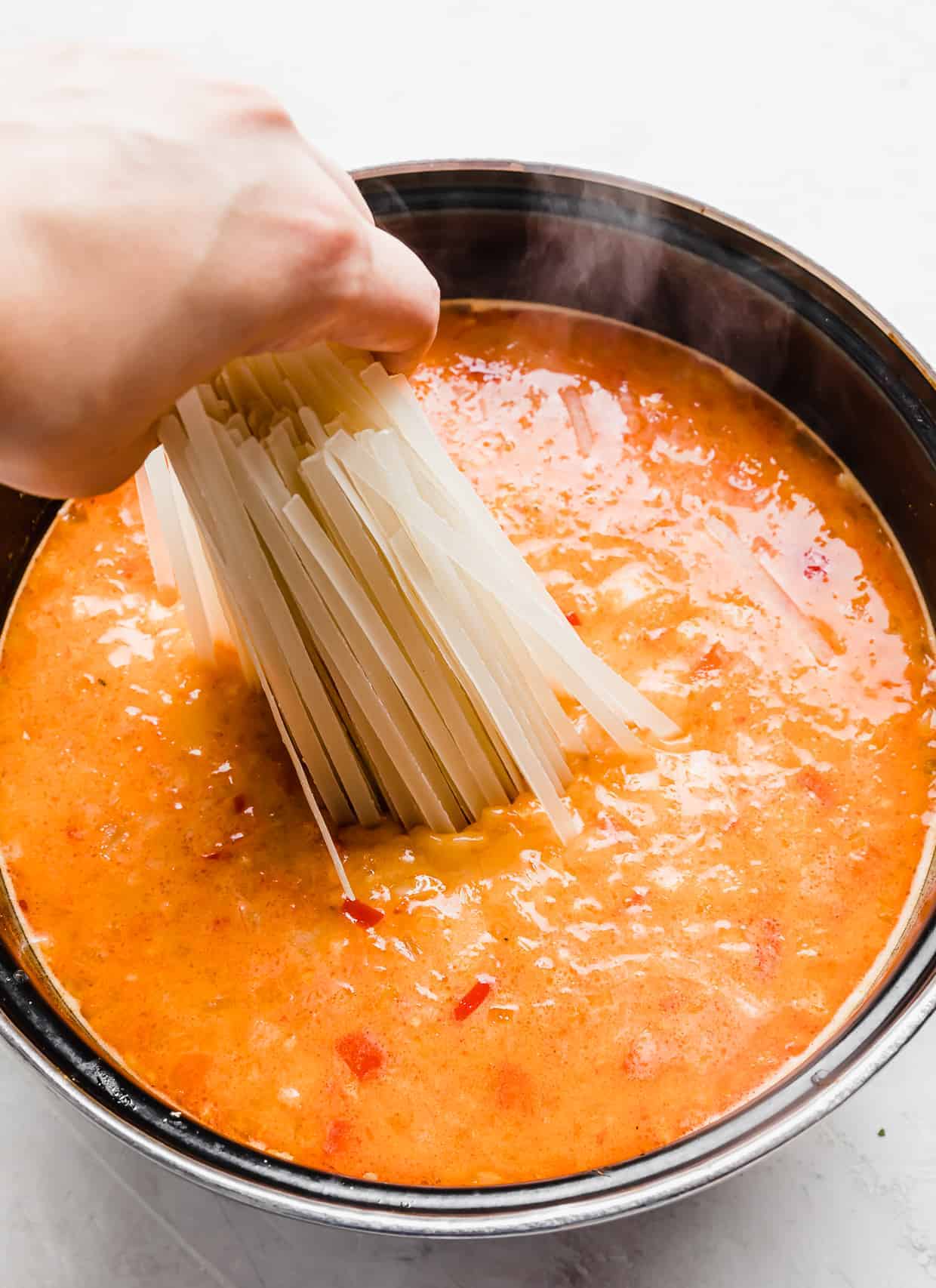
- Finish with Freshness: Remove the pot from the heat. Stir in the sliced green onions, fresh cilantro, chopped Thai basil (or regular basil), and the bright lime juice. The residual heat will gently wilt the herbs and release their aromatic oils.
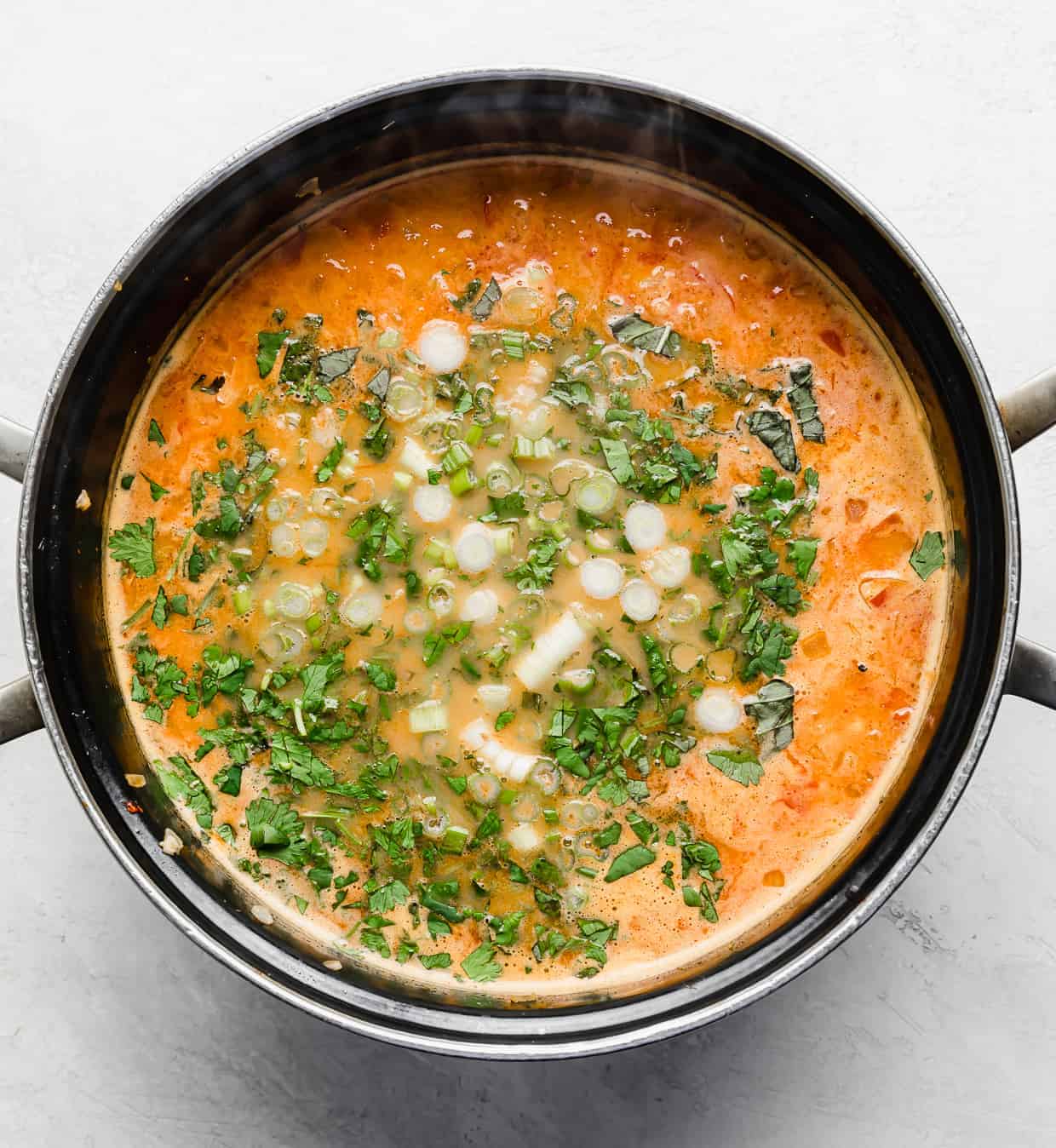
- Serve Immediately: Ladle generous portions of the hot soup into serving bowls. Garnish with additional fresh lime wedges, extra cilantro, or basil leaves for an appealing presentation and a burst of fresh flavor. Serve and enjoy this fragrant and comforting meal right away!
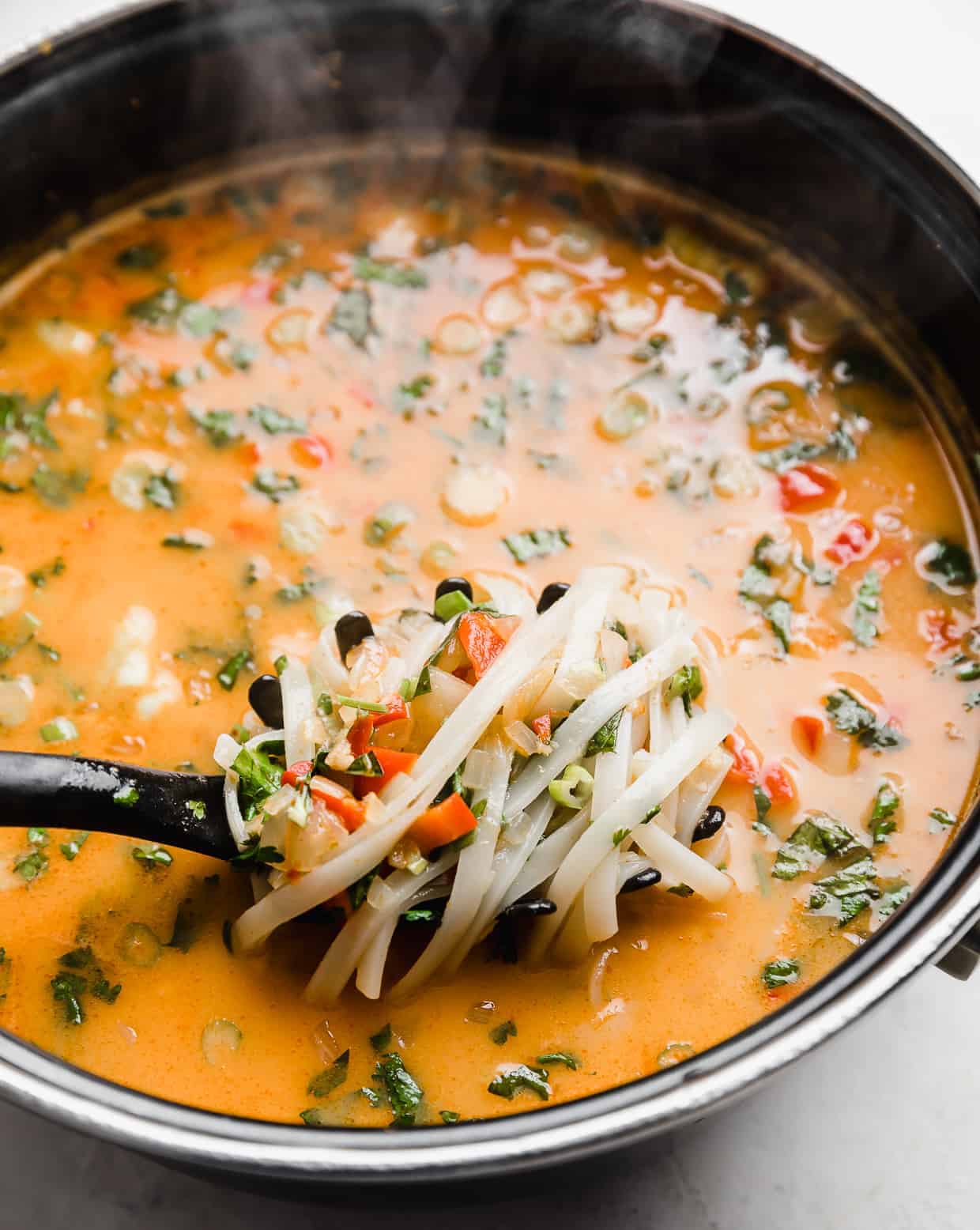
Expert Tips for the Perfect Thai Red Curry Noodle Soup
Achieve an even more outstanding bowl of Thai Red Curry Noodle Soup with these chef-inspired tips:
- Adjusting Soup to Noodle Ratio: If you prefer a richer, noodle-heavy dish that’s less soupy, simply reduce the amount of broth and coconut milk by half. This creates a thicker, more concentrated curry-noodle experience.
- Mastering the Spice Level with Red Curry Paste: The heat level of red curry paste can vary significantly between brands, and personal preference plays a big role.
- For Extra Heat: Don’t hesitate to double the amount of red curry paste. You can also add a pinch of dried crushed red pepper flakes or a few slices of fresh Thai bird’s eye chilies for an intense fiery kick.
- For a Milder Flavor: The 3 tablespoons of red curry paste in this recipe typically result in a mild-to-medium spice level. If you are very sensitive to spice or cooking for children, cut the amount of red curry paste in half. Always taste and adjust as you go!
- Enhance Freshness: A final squeeze of fresh lime juice just before serving brightens all the flavors. Don’t underestimate the power of fresh herbs as a garnish; they add both visual appeal and an aromatic burst.
- Storing Leftovers: This soup makes fantastic leftovers! Store any remaining Thai Red Curry Noodle Soup in an airtight container in the refrigerator for up to 3-4 days. The flavors often deepen overnight, making it even more delicious the next day. Note that the noodles may absorb more liquid and become softer upon reheating. You might want to cook noodles separately and add them to each serving if you anticipate a lot of leftovers.
- Serving Suggestions: This soup is a meal in itself, but it pairs wonderfully with a side of warm homemade naan or fluffy jasmine rice to soak up every last drop of the delicious broth. A simple green salad with a light vinaigrette also provides a refreshing contrast.
Frequently Asked Questions About Thai Red Curry Noodle Soup
As prepared in this recipe, our Thai Red Curry Noodle Soup is generally not considered very spicy. The red curry paste primarily contributes a rich, savory, and aromatic flavor rather than intense heat. True spiciness in Thai dishes often comes from added fresh or dried chili peppers like bird’s eye chilies, cayenne pepper, or crushed red pepper flakes. This recipe is designed to be approachable for most palates, with the option to increase the heat if desired.
Red curry paste typically has a warm, fragrant flavor with a mild to moderate underlying heat, depending heavily on the brand and how it’s used. It’s more about building a foundational flavor than delivering an immediate fiery punch. If you prefer a spicier dish, you can always increase the amount of red curry paste or supplement with fresh chilies or chili flakes. Conversely, reduce the amount for a gentler experience.
Traditional Thai red curry paste is a complex blend of aromatic ingredients. Its basic components usually include dried red chili peppers, shallots, garlic, galangal (a relative of ginger), lemongrass, kaffir lime peel, coriander root, coriander seeds, cumin seeds, and often shrimp paste. Variations exist, and some vegetarian versions omit the shrimp paste, so always check the label if you have dietary restrictions.
No, curry paste and curry powder are distinct ingredients, though they both contribute to “curry” flavor. Curry paste, particularly Thai curry paste, is a wet mixture made from fresh and dried ingredients ground into a smooth paste. It typically contains whole chili peppers. Curry powder, on the other hand, is a dry spice blend, often originating from Indian cuisine, composed of ground spices like turmeric, coriander, cumin, and fenugreek. Curry paste generally offers a fresher, more vibrant, and often spicier flavor profile compared to dry curry powder due to its fresh chili content and other aromatics.
While red curry paste is ideal for this recipe, a common substitute is curry powder. You could try a ratio of 1 teaspoon of curry powder for every 1 teaspoon of red curry paste specified in the recipe. Keep in mind that the flavor will be different, as curry powder lacks the freshness and specific aromatics of a traditional Thai paste. If you try this substitution, I’d love to hear how it turns out in the comments below! Alternatively, you can attempt to make a homemade red curry paste using the ingredients listed in the FAQ response above if you’re feeling adventurous and have access to fresh Thai aromatics.
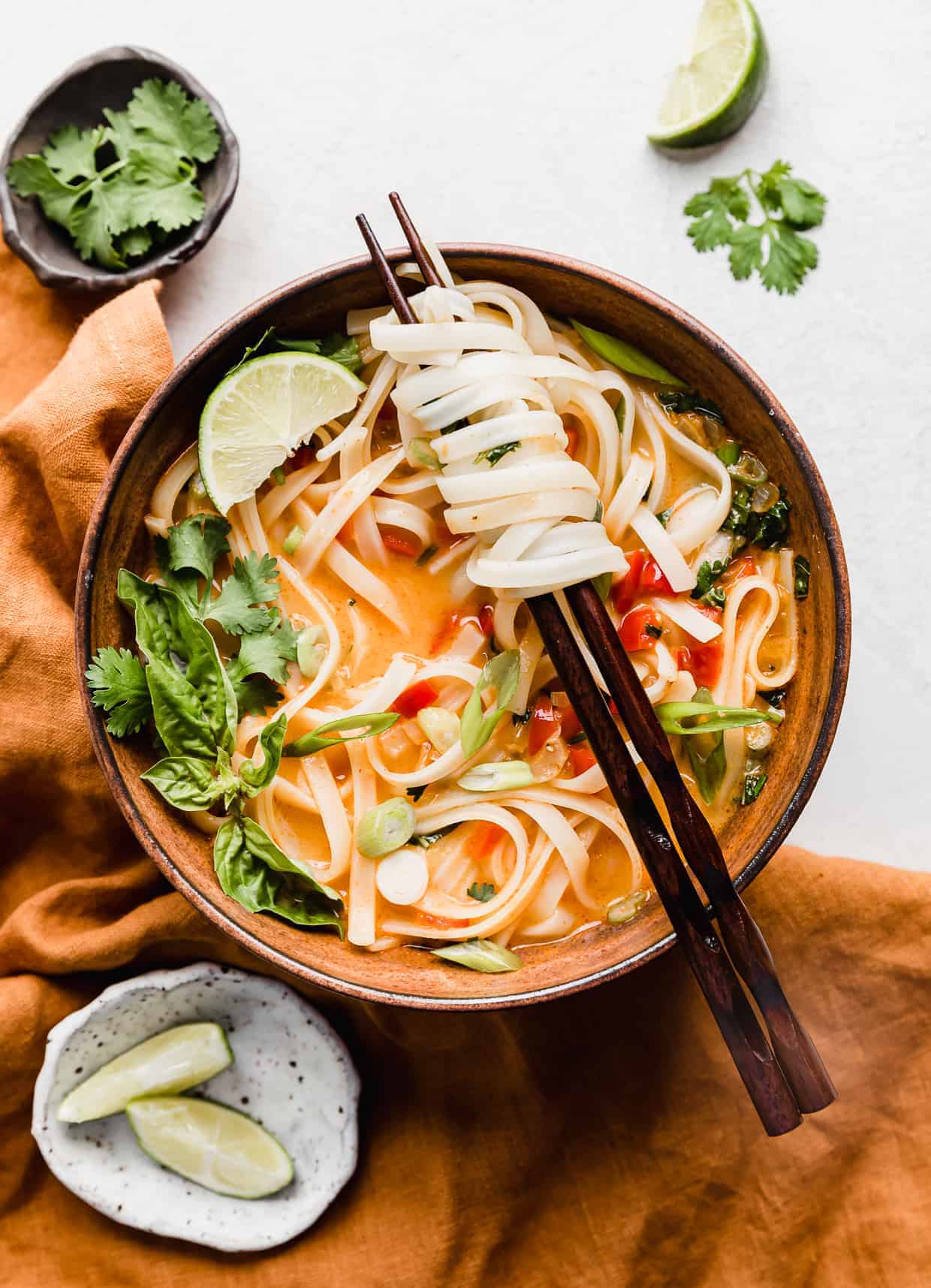
Explore More Delicious Soup Recipes
If you’ve enjoyed this Thai Red Curry Noodle Soup, you’re in for a treat with our other comforting and flavorful soup creations. Perfect for any season, these recipes are guaranteed to warm your soul and satisfy your cravings:
- Hearty Ham and Corn Chowder
- Creamy White Chicken Chili
- Zesty Buffalo Chicken Soup
- Sweet and Spicy Chili for a Kick
- Comforting Sausage Tortellini Soup
Did you make this incredible Thai Red Curry Noodle Soup recipe? I’d absolutely love to hear about your experience! Click here to leave a star rating and share your thoughts in a review. Your feedback helps other home cooks!
Stay up-to-date with our latest culinary adventures and recipes by following us on Instagram, Facebook, and Pinterest.
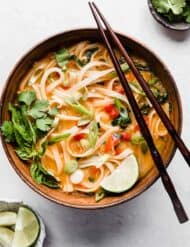
Print
SaveSaved!
Review
Thai Red Curry Noodle Soup
Ingredients
- 1 tablespoon olive oil
- 1 red bell pepper – diced
- 1 small yellow onion – diced
- 3 garlic cloves – minced
- 3 tablespoons red curry paste
- 1 tablespoon grated ginger
- 1 1/2 teaspoon kosher salt
- 1/2 teaspoon black pepper
- 6 cups low sodium chicken broth – or vegetable broth for a vegetarian meal
- 13.5 oz can coconut milk – I used full fat
- 8 oz linguini rice noodles – or any rice noodle variety
- 1 tablespoon fish sauce
- 2 teaspoons brown sugar – packed
- 3 green onions – thinly sliced (also referred to as “scallions”)
- 1/2 cup fresh cilantro – chopped
- 1/4 cup thai basil leaves – chopped (can use regular basil if you can’t find Thai basil)
- 2 tablespoons lime juice
Equipment
-
large pot (4 qt)
-
garlic mincer
-
Zester
Instructions
-
To a large pot or Dutch over set over medium heat, add the olive oil, bell pepper, and onion. Cook until the peppers and onion are tender and translucent, about 4 minutes. Add the garlic and cook for 1 more minute.
-
Stir in the red curry paste, ginger, salt, and pepper and cook until fragrant, 1 minute.
-
Stir in the broth and coconut milk. Bring to a boil. Once boiling stir in the rice noodles, fish sauce, and brown sugar. Cook until noodles are tender, about 4 minutes (time will vary depending on the noodle variety you use).
-
Remove from heat and stir in the green onions, cilantro, basil, and lime juice.
-
Portion into serving bowls and top with additional lime wedges and cilantro/basil leaves. Serve immediately!
Notes
Broth: You can use vegetable broth or low-sodium chicken broth, both taste great! If you’re a vegetarian, you would want to use the vegetable broth.
Coconut milk: I used full-fat coconut milk, but you won’t notice a difference in consistency and texture if you choose to use a lite coconut milk.
Rice noodles: I prefer a thicker/more substantial noodle so I went with linguini, however you can use any rice noodle variety you’d like. I also find this in the Asian/Indian cuisine food aisle of my grocery store.
Fish sauce: A common fish sauce substitute is soy sauce. However, in Thai cooking light soy sauce is preferred because it has a lighter and more delicate flavor than regular soy sauce.
Thai Basil: This basil has more of an anise type flavor to it with a bit more spice. If you don’t have it or can’t find it, regular basil works well too.
Protein: You can add protein to this dish by adding chopped, cooked chicken (rotisserie chicken or grilled chicken would work great here) to the soup. Shrimp would also be delicious!
Storing: Store in the fridge for 3-4 days.
Nutrition
